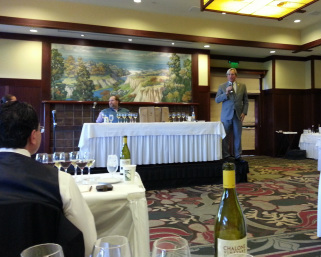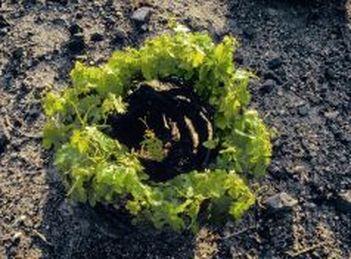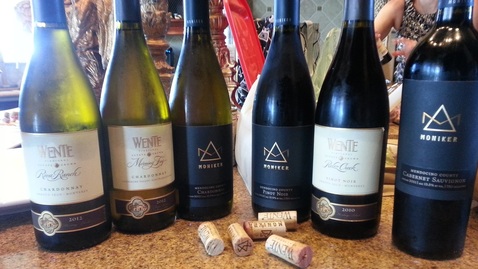|
NOTE: All wines tasted at this event were provided by the sponsoring wineries. Please see my page ' Submissions, Reviews, Invitations & Disclaimers'. Many of us are ‘seasonal’ wine drinkers; in other words, we tend to drink cozy reds in the winter and lighter, more refreshing wines in the warmer months. Not only do these choices fit our mood but also the food selections we make. With this in mind, the Wine Review Council met on a classic Southern California July evening to sample a selection of wines perfectly paired to our relaxing poolside setting. All the samples hailed from California, from producers large and small, both established and new and the evening brought a few surprises. Both the first and last wines were versions of Viognier from one of the newer wineries in Southern California, Estate d’Iacobelli (pronounced “de Yack-oh-belly). This small establishment opened the doors of their tasting room this past May, located in the town of Fallbrook, located between San Diego and Temecula. The owners, Ronei and Lisa Iacobelli, are originally from Michigan, but their love of wine and Italian heritage brought them to the Temecula Valley in 1998 where they bought 20 acres and planted vines and olive trees. They decided, however, to build their tasting room on a beautiful hillside overlooking the Pala Mesa Golf course. The 2011 Estate d’Iacobelli Viognier is refreshingly fragrant with crunchy green pear, orange blossom and peach leading to a somewhat creamy palate with nectarine and lime zest on the finish. Not your typical Viognier, but delicious just the same. Retail $32.00. The companion wine, 2010 Estate d’Iacobelli “Sticky Fingers” LH Viognier was a terrific finish to the evening. Baked pear and nutty cashew mingled with lemon drop! The finish was not syrupy or overly sweet. It would make a perfect ‘little something’ after dinner. Retail $26.00. Both wines are available at the tasting room or through their website. Moving further north to Mendocino, we sampled three offerings from Moniker Wine Estates. A creation of three generations of the Thornhill family, the name and logo honor the multiple generations working together to create this premium line of wines. First up was the 2012 Moniker Chardonnay. The majority of the fruit was sourced from the Ribera vineyard located on the banks of the Russian River. The wine was barrel fermented for four months in American oak and, prior to bottling, blended with a bit of Viognier and more Chardonnay that was aged in French Oak. The result is a subdued and somewhat elegant Chardonnay, with soft apple, spicy cinnamon and notes of baked pear. The sur lie aging lends a soft mouth feel and good acidity keeps the finish fresh. Retail $23.00 Pinot Noir is always a great choice for summertime cuisine and the first one we sampled was also from Moniker. The 2012 Monkier Pinot Noir is a blend of grapes harvested from three Mendocino vineyards located in Anderson, Redwood and Potter Valleys, aged in American oak for seven months. The wine is all red fruits – rhubarb, cherry and red plum, highlighted with notes of fresh tobacco and tealeaf. Retail $30.00 Our last selection from this producer was the 2011 Moniker Cabernet Sauvignon. Although I wouldn’t normally consider this variety as a ‘summer sipper’, one can never say no to a California Cab! This bottling received Double Gold at the 2014 San Francisco Chronicle Awards. Aged for fourteen months in three year old French oak barrels, the wine lets the fruit do the talking. Black cherry, spicy plum and vanilla notes on the nose and palate linger on to the finish. This wine would definitely benefit from some more time in the bottle to fully show itself. Retail $30.00 From newer wineries on to a familiar name in the pages of California wine history: Wente Vineyards. Founded in 1883, Wente is the oldest continuously family owned winery in the United Sates. They began with 47 acres, planted by founder C.H. Wente and have now grown to 3000 acres, still in the Livermore Valley AVA. The Wente family have always contributed to the growth of the wine industry: first to put the grape variety name on the label, founders of the California Wine Institute and of course, the development of the now prolific Wente Clone of Chardonnay. They were honored as the American Winery of the Year in 2011 by Wine Enthusiast Magazine and in 2010 became a Certified Sustainable Vineyard, part of their “Family for the Future” campaign. To be honest, I had not tasted any of their wines for a very long time. Call me a snob, but I just hadn’t. I was in for a pleasant revelation. We first sampled the 2012 Wente Riva Ranch Chardonnay. This is part of the “Heritage Block” Series utilizing grapes from vineyards named after some of the pioneers of Wente winemaking. They are located in the Arroyo Seco region –considered one of the prime Chardonnay areas since the 1960s. The grapes were fermented in a combination of French, American and Eastern European barrels and stainless steel. The result is a tasty, New World Chardonnay. Vanilla beans, soft toast, baked apples with nutmeg and hints of tropical pineapple. Retail $22.00 The second sample from this historic producer was the 2012 Wente Morning Fog Chardonnay. Named after the cooling mist that flows from San Francisco Bay over the vineyards of the Livermore Valley, the wine is aged half in stainless steel and half in new French, American and European oak barrels. All the wine is aged sur lie for seven months. Elegant and enticing soft apple, lemon curd and spicy ginger show on the nose and palate with soft toasty, brioche, peach and applesauce lingering on the finish. Part of the ‘Vineyard Selection’ Series. Retail: $12.00 Our third and last taste of Wente was red - the 2012 Wente Reliz Creek Pinot Noir. The fruit once again is sourced from the vineyards of Arroyo Seco in Monterey. The soil here is gravelly loam with shale and limestone, lending structure and minerality to the wine. The wine spends twenty months in a blend of French and European neutral oak. The lovely cherry red hue matches the perfumy nose filled with cherry, black raspberry, and toast. The palate is deeper with notes of raspberry preserve, dark strawberry and earthy note of kirsch. The finish is clean with touches of white pepper. All in all, a feminine, Old World influenced Pinot. “Heritage Block Series” Retail: $28.00 At the end of each Wine Review Council tasting, we all rank the wines according to our personal preferences. For once, the votes were all swayed in one direction: the Wente Way! First place went to the Wente Reliz Creek Pinot Noir, with the Morning Fog and Riva Ranch Chardonnay’s sliding into second and third. Varietal character, value for money and food compatibility lead to most of our conclusions, So, until next time, happy sipping, whatever the season. NOTE: All wines tasted at this event were provided by the sponsoring wineries. Please see my page ' Submissions, Reviews, Invitations & Disclaimers'.
1 Comment
 One of the great perks of being involved with the wine industry, in all its many permutations, is the chance to taste and learn on a continual basis. Most of the offerings from wineries, especially larger producers or those affiliated with the more ‘corporate’ establishments, are focused on sales. After all this is the wine ‘business’ and without sales we would all in a sad state. But every now and again an invitation appears for a more ‘educational’ experience and these are the ones that get me excited. Such was the case last month when I attended the “Sommelier Series” event sponsored by Chalone Vineyards. The seminar was held at the stunning Lodge at Torrey Pines in La Jolla, CA. This elegant, craftsman-style resort is home, I’m told, to a legendary golf course but my focus was on the wines!  The workshop was conducted by Robert Cook, Winemaker for Chalone and Gilles de Chambure MS with a comparison tasting of several vintages from Chalone Vineyard and wines from Bourgogne.  Chalone Vineyards were first planted in 1919 by Frenchman Charles Tamm. It seems he was searching for soil that reminded him of his native Burgundy and found them in this limestone rich terrain in the shadow of Pinnacles National Monument .  Today, these are the oldest producing vineyards in Monterey County and produce award winning Chardonnay and Pinot Noir, just as Monsieur Tamm had dreamed of! In 1966, under owner/winemaker Dick Graff, Chalone set the standard for California Chardonnay and today, although it is owned by a large corporation (Diageo Chateau & Estate Wines), the wines are still crafted with respect for both the vineyard and the distinctive terroir. These wines certainly held their own when tasted against two delicious vintages from Burgundy and the passion of both gentlemen enhanced the experience. I shall be writing more extensively on the terroir, history and vintages of the Chalone AVA in the near future (more on that to come - stay tuned!). A big “Thank you” to Angela Bortugno and Lauren Watters of Chalone Vineyards for organizing a well orchestrated and classy event. Speaking to the other Sommeliers and educators, it was a terrific experience all around and Chalone should expect quite a few industry visitors in the months ahead. Disclosure: Wine tasting is a highly individual experience and, scientifically, none of us perceive wine in exactly the same way. The opinions expressed in this post are mine and mine alone and although the wines sampled were supplied by the designated wineries for review I describe them as I see them.  The connection between the grapevine and Greece is almost as old as wine itself. The ancient Greeks spread viticulture throughout the Ancient World and, for them, wine was not just a commodity but life and culture as well. So with this long history in mind, it was with great excitement that I joined with other members of the Temecula Wine Council to sample five wines kindly supplied by the “New Wines of Greece”. For many of us, when we here “Greek wine” we immediately think of ‘Retsina’, perhaps crafted in rustic old wineries from grapes we can’t pronounce! I am glad to report that nothing could be further from the truth. There has been a mammoth revival in the Greek wine industry, beginning in the late 20th century. Many local winemakers, who ventured to wine producing areas throughout the world, have returned to their roots, building shiny new production facilities that rival those of the ‘New World’. While embracing many new winemaking techniques there is desire to blend them with time-honored philosophies such as biodynamic and organic viticulture and the use of indigenous grape varieties. And so, we gathered at the Dorland Mountain Arts Colony, just outside Temecula, CA. The fresh air and solitude made for the perfect venue. Each of the six members attending the tasting were assigned one of the wines and asked to prepare a compatible dish for everyone to share. As you will discover, much of the fare paired well with many of the wines, showing just how food friendly and versatile these vintages turned out to be! First up was “Thema 2012” from Pavlidis Estate near the Macadonian town of Drama in northern Greece. A 50/50 blend of Sauvignon Blanc and Assyrtiko, (ah-SEER-tea-ko) the wine is a prime example of old meets new. The region of Macadonia has been a prime grape growing area for millennia and founder Christoforos Pavlidis has been cultivating both native and international varieties since 1998. The winery embraces modern viticulural practices on its 148 acres planted on a variety of soils in two vineyard sites. The winery itself is state of the art and visitors are welcome in their modern tasting room located on the “Wine Road of Dionysus”. The wine was delightful, with a subtle, elegant nose of lemon cream enchanced with touches of fresh green herbs. The zippy acidity and lime zest flavor accentuated the saltiness of the smoked salmon brought to pair with it. Our second vintage came to us from the home of the famous Greek varietal, Assyrtiko – the Aegean island of Santorini.  courtesy New Wines of Greece.com courtesy New Wines of Greece.com Domaine Sigalas Assyrtiko-Athiri 2011 is another example of traditional grape varietals truly showing their ‘terroir’ through more modern production. Domaine Sigalas was founded in 1991 and by 1998 had constructed a brand new winery/production center near Ola, in the northern part of the island. Their 47 acres of vineyards are planted on volcanic soils comprised of cinders, lava and pumice. They specialize in indigenous grape varieties grown in the traditional manner unique to Santorini. Vines are trained low to the ground, woven around itself like a round basket. This format, called a Kouloura meaning wreath or basket, protects the vines from strong winds and also shields the grape clusters from the intense, direct sunlight. The wine was a prime example of how the local white grapes of Greece have evolved to withstand the heat and sun of the Mediterranean without losing any of their distinctive, refreshing acidity. The clean, citrusy aromas were a true indication of what was found in the glass! Amazing, racy, mouth-watering acidity combined with a slight hint of sea air minerality and touches of lime blossoms. It was a terrific compliment to the steamed artichokes in olive oil, herbs and seasonings; the wine acting like a spritz of brightness, bringing out the flavor of the vegetable and freshness of the herbs. The last white of the evening also hailed from Macadonia - Ovilos Estate Biblia Chora 2010 a blend of a traditional native grape (50% Assyrtiko) and an international variety (50% Semillon). Vineyards here were first planted by the Phoenicians who found this “Golden Mountain” while in search of precious metals. Alexander the Great mined gold here to finance his expeditions and the Cult of Dionysus (or Bacchaus to the Romans) made their wines from Macadonian fruit. But enough history! The winery’s founders both studied in Bordeaux and returned to their homeland to make wine. The original 70 acres were planted in 1998 and now there are close to 350, all of which are farmed organically. A modern winery, built to resemble a grand Bordelais Chateau, was built in 2001 and their efforts have paid off; the wines have won numerous awards throughout the world.  This blend had a beautiful brilliant gold appearance, reflecting the 8 months the wine spent in oak. The aromas were clean and fresh with notes of golden apple, soft fruit blossom florals and a suggestion of dried apricot. The palate was supple and honeyed showing touches of mango and toasted pine nuts. It went very nicely with the food I had paired – grilled chicken Breast with herbed zucchini stuffing. The wine lifted the herbaceous notes in the dish and surprisingly, also complimented the artichokes and another traditional dish – Moussaka. Next up was the first red,“Xinomavro 2008 Urano” from Thumiopoulos Vineyards in Naoussa, also located in Macadonia. This winery is owned by Apostolos Thumiopoulos who, at the tender age of 31, is acknowledged as the ‘rising star’ in this famous wine growing region, Naoussa. His vineyards, all biodynamic, are planted on complex soils – a mixture of marl, schist and granite - in the southern part of the appellation. The winemaker embraces a minimally invasive philosophy when it comes to making wine, letting the grapes express themselves and showing their unique character, vintage to vintage. He uses naturally occurring yeast and little, if any, filtration to produce terroir driven results. This wine, made from the native Xinomavro (ksee-NO-mah-vro) varietal, showed aromas of dark strawberry jam laced with white pepper and soft touches of toasty rye bread. Dried tomato and a slightly spicy note lingered on the finish. The tannins and acidity were nicely balanced, which made it a wonderful compliment to the tasty ‘Boubaria’ – a traditional meat sausage of the area, bringing out spicy notes of cumin. It also paired beautifully with the Moussaka and some decadent spiced fig cakes! Our final wine of the evening kept us in the appellation of Naoussa and was also an expression of Xinomavro –“2007 Boutari Grande Reserve Naoussa.” The name Boutari is a familiar one around the world. It is the regions oldest winery – its history goes back 130 years – and has been an ambassador for Naoussa, the Xinomavro grape and Greek wine for almost as long. The vineyards are on the south-east slopes of Mount Vermio where the grapes enjoy lots of sunshine, generous rainfall and are shielded from the cold northerly winds. The marl soils, a mixture of limestone and clay, give the wines their rich body and ageing potential. The Grande Reserve is one of Boutari’s most collectable red wines and this vintage still has room to mature. Prune, plum and baking spices abound on the nose and palate with ripe dark berries and vanilla hanging on through the finish. The tannins are still firm and the acidity bright. Definitely a wine you would want to cellar or use a decanter or aerator to enjoy now. Also on hand was a fantastic Greek dip – feta, oregano, kalamata olives, and sun-dried tomatoes – served with pita chips that went with a variety of the evening’s wines. And lest we forget to mention the sinful chocolate brownies – frosted no less! As expected, they were a treat with both red wines and made a suitable ending to our feast. It was a terrific and enlightening group of wines that made me want to go out and find other “New Wines of Greece” to explore and enjoy. As they say in Greece “Yia Mas” - Here’s to Health! |
AuthorWine lover, educator and writer. Archives
March 2017
Categories
All
|






 RSS Feed
RSS Feed

